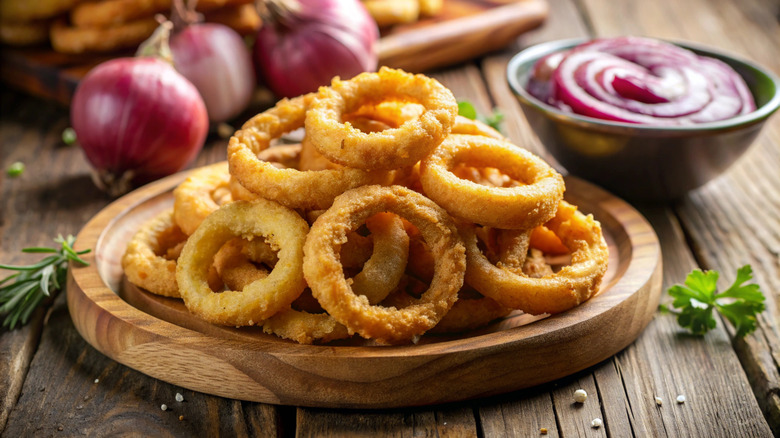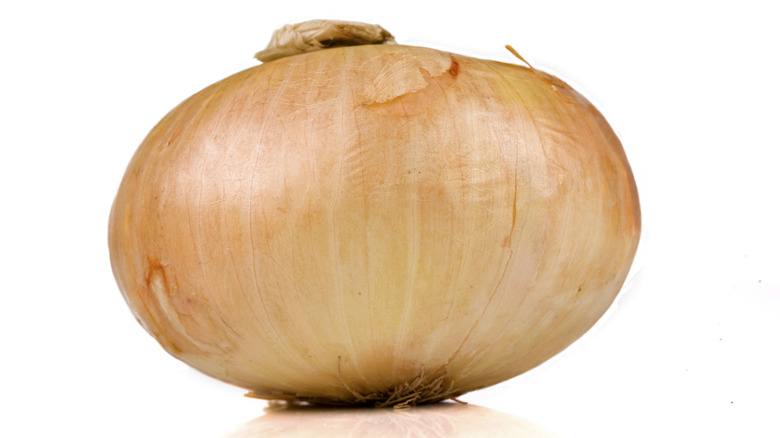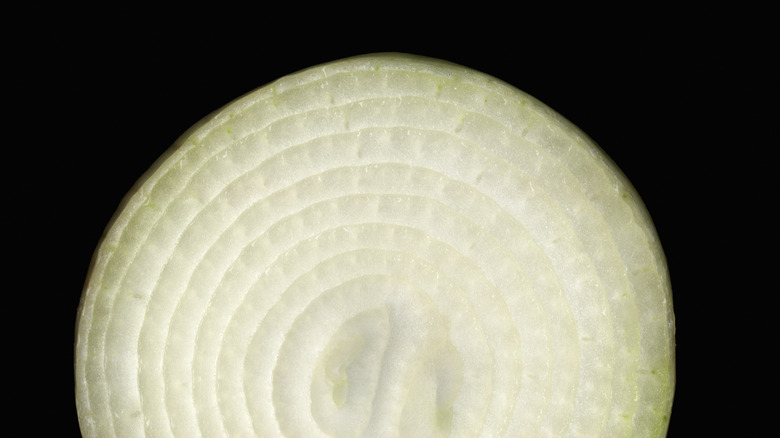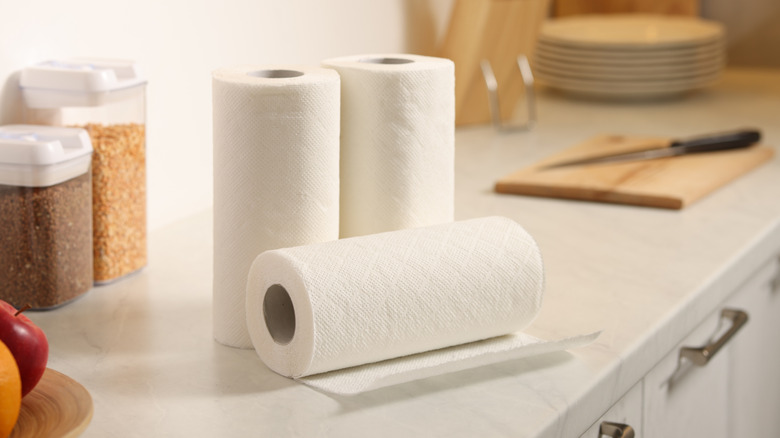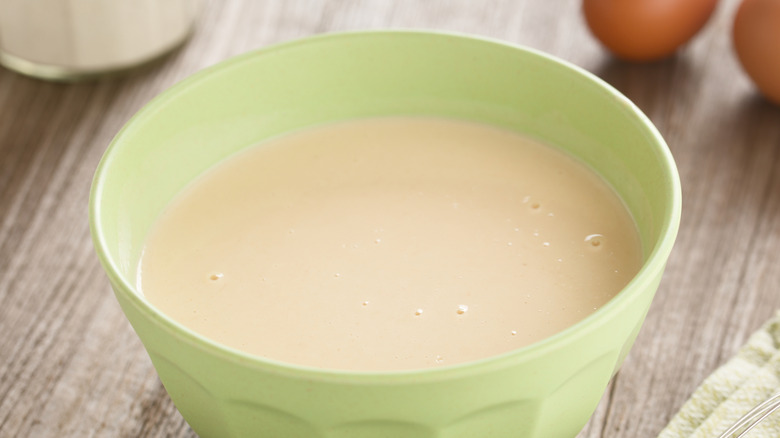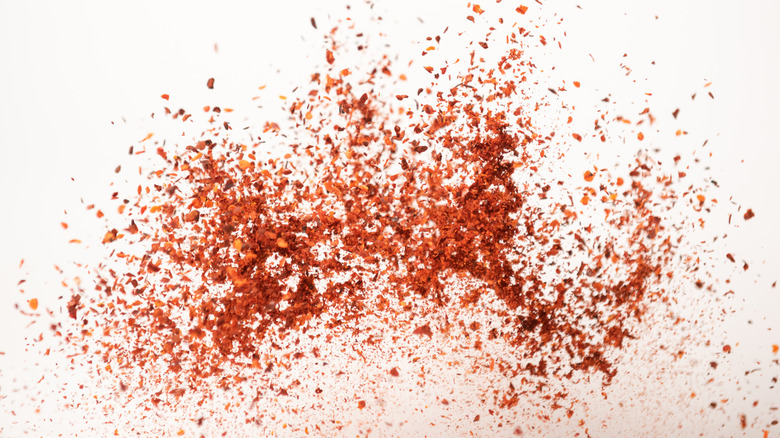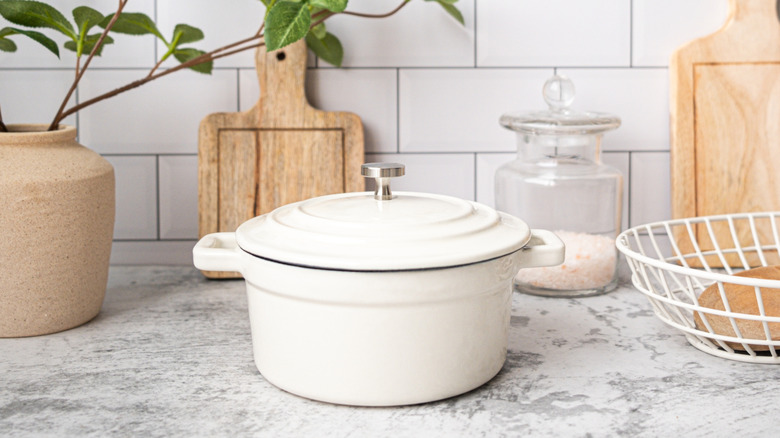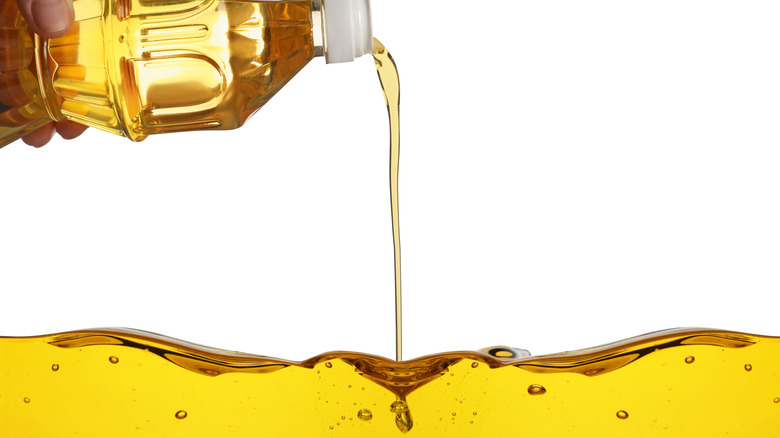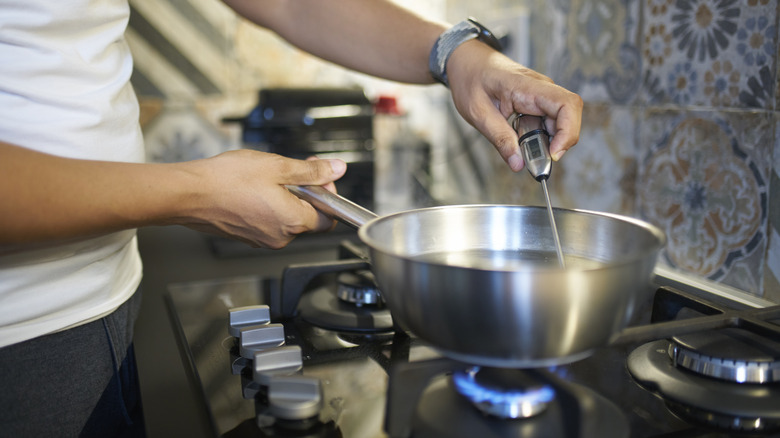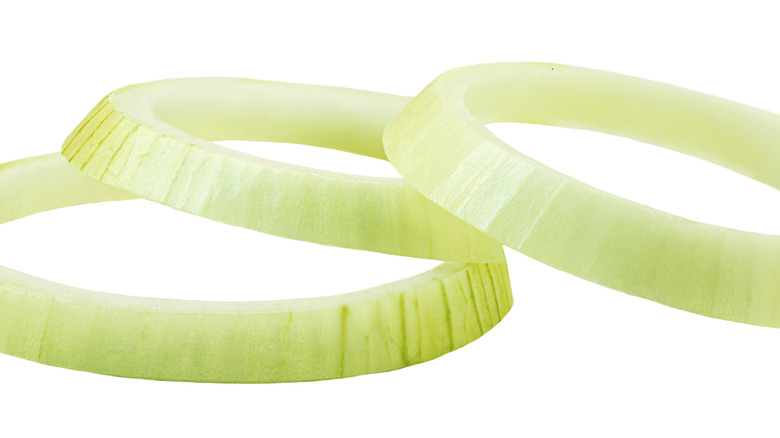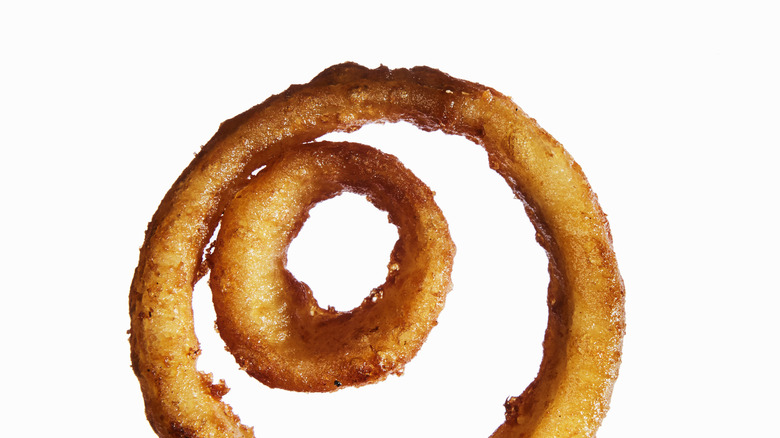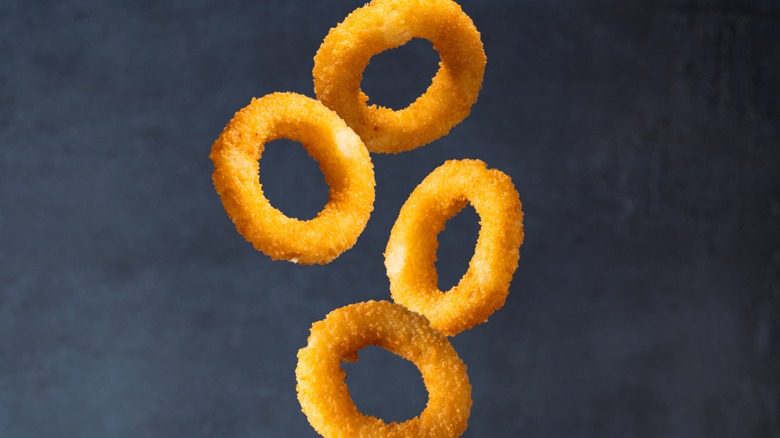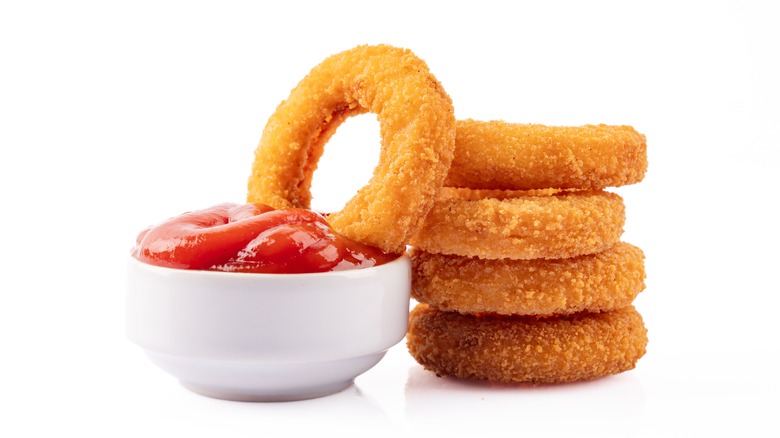13 Tips For The Absolute Best Homemade Onion Rings
We may receive a commission on purchases made from links.
Whether you pick them up at a fast-food joint or bake up a batch you picked up from the grocery store frozen food aisle, onion rings are almost always a crowd-pleaser. When done right, they're hot and crunchy and salty and delicious. That said, they certainly vary from brand to brand, as we discovered during our fast food onion rings taste test. But what if you could make them yourself whenever you wanted? The good news is that great onion rings are far from impossible, even for amateur chefs.
"The key elements are flavor, texture, and structure," says Jennifer Pallian, a registered dietician and the creator of Foodess. "You want a mild, sweet onion that doesn't overpower, a crisp coating that clings tightly without slipping off, and a texture contrast between the crunchy exterior and tender interior." If you do it right, she says, "The fragrance should evoke fresh frying oil and light caramelization without being greasy."
Just because it's achievable, however, doesn't mean making great onion rings is an intuitive process. That's where expert opinions can come in handy, so here are a variety of tips to help you create the best homemade onion rings today.
Use the right onions
Unfortunately, not all onions are created alike. Certainly, you should not treat onions and shallots as interchangeable, for example, and the same goes with other species (e.g. cippolini onions). You shouldn't sub in different onions than your recipe calls for, either. Is there really a difference between your basic yellow and white onions, you're wondering? As it happens, yes. Kind of a big one. So for the best homemade onion rings, your first tip is to use the variety for which the recipe calls. Typically, that's going to be a sweet onion.
"My first choice is a Vidalia onion," says Andre Barbero, executive chef at Harpoon Willy's. "Vidalias are freshest in the spring. However, their supply usually doesn't last past the end of summer. The rest of the year I prefer a Maui or Walla Walla onions." Jennifer Pallian also recommends using sweet onions. "They have a lower sulfur content and higher sugar levels, so they mellow nicely when cooked and develop a subtle sweetness," she says. You should avoid, Barbero adds, anything labeled as a Spanish or "cooking" onion.
Slice onions thicker than you think
Cutting onions uniformly is a famously difficult task, and that's before you add all the crying. The good news is that you don't have to cut your onions too thinly when making rings (although when you do need a super thin result, there is an incredible onion-cutting tip to help you out). For the purposes of onion rings, though, you're shooting for evenness rather than thinness.
Indeed, the chefs say, you don't want your rings thinner than half an inch thick, because they need to hold up to frying. Plus, you need some surface area for your batter or dredge to stick to, which is why the best homemade onion rings aren't too dainty. A half-inch, Jennifer Pallian says, will help you hit the delicate balance between structural integrity and a tender, melting onion. Get a good sharp knife, such as a Steel Japanese Chef Knife, to slice through those onions like butter. Keep the good-sized rings and reserve the onion's core for other uses, such as soup.
Soak and dry the onions thoroughly
Once you've sliced your onion rings and reserved the smaller bits for later, Jennifer Pallian advises. "Discard any double-membrane rings that may cause the batter to slip off," she says. Membranes also cook unevenly, shrinking more than the main part of the onion, causing the batter to burst and leading to an unevenly fried result which certainly won't win you the trophy for best homemade onion rings.
For this, Tregaye Fraser, a celebrity chef at Virtual Xperiences, has a stellar tip: soak the rings in ice water for 30 minutes. This will "mellow their bite and enhance their natural sweetness." This also makes it easier to peel away the membrane. If you find that still doesn't work well enough, you can also freeze them for the same amount of time. Once thawed, that membrane will slip right off. But, Pallian warns, "After soaking, it's really important to dry them thoroughly with paper towels — any residual moisture interferes with batter adhesion and can cause splattering in the oil."
Choose batter or dredge
To get the best homemade onion rings, you need the right recipe. "It's all about the crunch and that flavor punch," Tregaye Fraser says. "You want a golden, crispy exterior that shatters with every bite, encasing a tender, sweet onion center. Texture is king, and every layer — from the batter to the breadcrumbs — must be packed with flavor."
You can get this with either a batter, which is a liquid into which you dip your onion rings, or a dredge, a coating that you adhere to your onion rings with the use of a wet-dry dip method. For instance, Fraser's favorite tip is to use a three-step process: seasoned flour, an egg wash, and panko breadcrumbs. "The panko gives an extra crunch, and letting the breaded rings rest for a few minutes before frying ensures the coating sticks perfectly," she says. Note that panko is a style of bread crumb, not a brand, so you can use any, such as Kikkoman Panko Japanese Style Bread Crumbs.
Jennifer Pallian, who likes her rings both ways, says that her choice depends on how she's serving them. "A batter gives the classic restaurant results — airy yet substantial. I love this when it's a main part of the meal," she shares. "When I make onion rings for a party or appetizer where there's a lot of food still to come, I will often go for the dredge method, which gives a lighter result that is less filling." Of course, if you prefer a batter, that's totally fine. "For me, a battered onion ring is the best onion ring," Andre Barbero says. Experiment to see what works.
Make sure batter or dredge is thick enough
The best homemade onion rings always have a nice, thick, crunchy outer coating. Whether you achieve that with batter or a dredge process is up to you, but either way, make sure the consistency is right. If you're going to use a one-bowl batter, Andre Barbero says, "Your batter should resemble thick pancake batter. If it is too loose, add additional flour. If it is too thick, add additional buttermilk. Be careful not to overmix the batter, as that will impact the lightness of the final product."
Either way, Jennifer Pallian has a trick for getting a thick enough coating. If you're battering, she says, "Start by dusting the onion rings in flour to help the batter grip, then dip them into a seasoned batter made with cold club soda or beer. The carbonation creates lift and lightness in the crust." Note that if your recipe uses beer and you either don't have it or try to avoid it, there are several substitutes you can use, including soda, nonalcoholic beer, or sparkling wine. Each of these will give you the necessary effervescence in place of beer or ale.
And if you're going to dredge, make sure to add ½ teaspoon of baking powder for each cup of flour. This will help ensure you get a thick coating of batter without it becoming too heavy: "The baking powder reacts during frying to create small air pockets, resulting in a lighter, crunchier crust."
Season your batter or dredge well
It's not enough to nail the texture, though. The best homemade onion rings have great flavor as well. "The secret really lies in the seasoning — every layer counts," Tregaye Fraser says. "A sprinkle of salt immediately after frying, or even experimenting with crushed cornflakes or potato chips in your breading, can elevate the dish to a whole new level." Personally, Fraser says, she loves taking classic comfort food and reinventing it with bold, modern twists, an approach that works well in the always-hopping food scene that is Atlanta. Her favorite tip is to mix lots of flavors into her flour: garlic powder, paprika, cayenne, salt, and pepper when using the dredge method.
Andre Barbero likes to mix Tabasco, white vinegar, and Worcestershire sauce into his batter. Like Pallian, he uses baking powder along with the flour to get a crisp and airy result, and he uses buttermilk for a nice, tangy, lightness as well. The buttermilk will activate the baking soda, lightening things up even further.
There are other styles of onion ring seasoning too, of course, such as Italian herbs or a bit of sugar, believe it or not. If you really dig that allium flavor, you can even season onion rings with onion powder. McCormick Onion Powder gives you a good bang for your buck, while Simply Organic White Onion Powder is a highly reviewed option if you care about the sourcing.
Use the right cookware
The right cookware really matters, because some pots just don't distribute heat well and can lead to an uneven result. "I use an enamel-coated cast iron pot such as a Le Creuset," Andre Barbero says. "If you don't have one of those, a heavy-bottomed stainless steel sauce pot, preferably with a dual bottom would be my choice."
Pallian agrees that a heavy-bottomed pot like a Dutch oven is a solid choice, but she likes a wok best. "Its wide top and sloped sides give you more surface area with less oil, making it super-efficient," she says. "You can fry the same amount of food with a smaller oil volume than you'd need in a straight-sided pot."
A Lodge 6 Quart Enameled Cast Iron Dutch Oven with Lid or a Yosukata Carbon Steel Wok Pan will both give you great results, depending on which cooking tool feels more comfortable to you. Just note that woks tip easier and frying oil is dangerous, so either take great care or buy a wok stand, such as the M.V. Trading New Star International NCWS9 Steel Wok Rack.
Pour plenty of oil in the pan
Look, folks, we're deep-fat frying something here. This isn't the place to skimp on fat, not if your goal is to make the best homemade onion rings ever. Plus, hot tip (no pun intended): hotter oil results in less oil absorption into the food, so as long as you fry at the right temperature, you're really not absorbing all that much. Your best bet is to follow the recipe, neither over- nor under-portioning your fat.
"Use 2 to 3 inches of neutral oil that can withstand high heat," Jennifer Pallain advises. "Canola or peanut oil are both good options." Both of these oils have a high smoke point, which means you can get them piping hot without risking them burning or smoking, an outcome that will affect both your final product and the livability of your kitchen.
Make sure it's hot enough
Temperature matters. For onion rings, make sure your frying oil is between 350 F (the temperature advised by Jennifer Pallian and Tregaye Fraser) and 375 F (the temp preferred by Andre Barbero). The best homemade onion rings are evenly cooked, crunchy, and crisp without a bit of burning, which means you need to make sure your oil neither heats up nor cools down during the process.
The best tip? "Monitor the temperature with a thermometer for consistency," Jennifer Pallian advises. The ThermoPro TP03B Digital Meat Thermometer is perfect for this, but it will work for meat, candy, and other applications as well. You can either take readings at intervals or you can clip the thermometer to the side of the pot and keep an eye on it.
Do a test ring
Before you go gangbusters and toss all your onion rings into the frying oil, do yourself a favor and test one first. That way, if you need to adjust something, you can do so without ruining half your batch. As a bonus, while you test the first ring, you can batter the rest and let them sit for a minute. This might seem like a weird tip, but it's actually important, Jennifer Pallian says: "One often-overlooked step is letting the battered onion rings rest for a minute or two before frying. This allows the coating to hydrate and thicken up, which helps it adhere better and reduces batter slippage during frying."
Keep a close eye on your test ring while it's frying. Typically, Tregaye Fraser says, "About 2 to 3 minutes in the oil is usually enough until they're golden and floating. It's a quick process that requires precision to avoid overcooking, which can lead to a burnt taste instead of that perfect crunch." Remember that when you only have one ring in the fryer, the overall oil temperature won't drop as much as when you add several, so this cooking time might be even shorter.
How can you tell if they're done? You're looking for a golden-brown exterior, Andre Barbero says. Once you see that, the interior will be cooked. Pallian advises resisting the temptation to overcook. "If your onion rings are thicker or you're worried about raw centers, you can hold them in a 200 F oven after frying for a few minutes," she says. "This keeps them hot and allows the onion to finish softening without over-browning the crust."
Keep onions separated in the fryer
You know what won't lead to the best homemade onion rings? Clumps of indistinguishable veggie and batter mush. Perhaps the most important tip you'll learn today is to "Fry in small batches to maintain oil temperature and prevent crowding," Jennifer Pallian says. This matters in and out of the pan, she adds. You shouldn't place them on paper towels, which can cause them to get soggy. Instead, "Drain on a wire rack set over a baking sheet to preserve their crunch." Also, don't let them rest against one another after you've pulled them out, which can cause the same problem.
It's also important to take care when you place the rings in the fryer, Andre Barbero says. "Gently place the rings into the oil, being careful not to overcrowd the oil." Add them one at a time, making sure there's room before adding another. Then use a tool to gently separate them while they fry, if needed. You can use a spider to take them out of the oil, Barbero adds. The Hiware Solid Stainless Steel Spider will do the job nicely.
Salt them upon removal
Hopefully, you seasoned your onion ring batter or dredge well, but that's still not enough flavor for the best homemade onion rings. "Regardless of how much salt your recipe has in the batter or coating, always immediately salt fried foods once you remove them from the fryer," Andre Barbero says. "That is the perfect time for an additional layer of seasoning to stick to the item, while it still has some surface fat on it." Thus, as soon as you pull the onion rings out and set them on the rack, salt them generously to taste.
If you can't eat them right away, Barbero adds, you can put them in a 200 F oven until you're done frying the rest of them. That will keep them crunchy enough. "Lastly," Jennifer Pallian says, "onion rings are best enjoyed fresh. If you must reheat, use a hot oven or air fryer to revive the crispness." The Chefman TurboFry Touch Air Fryer is a highly reviewed option if you're in the market for an air fryer (although this writer found hers for $15 at a thrift shop and it's been great).
Serve them with a great sauce
All the best homemade onion rings come with a great sauce. If you don't have time to go all out, though, there's no need to stress. "Nothing beats Heinz ketchup," Andre Barbero says jovially, echoing the inner child in each of us. Now there's a tip we can get behind.
But, he adds, if you have the time to whip up something a little more special for your guests, a good fry sauce is always nice. His is a take on the Bloomin' Onion Sauce, an Outback Steakhouse takeoff. He mixes ½ cup of mayo, ⅓ cup of ketchup, 1½ tablespoons of prepared horseradish, ½ teaspoon of paprika, and ¼ teaspoon each of Tabasco and Worcestershire Sauce. To make the sauce, he says, "Squeeze the prepared horseradish dry. Combine all ingredients in a small metal bowl with a whisk and chill for at least 2 hours. Serve with onion rings, French fries, or fried seafood such as shrimp, oysters, or clams."
As for Tregaye Fraser, "I'm all for a zesty comeback sauce — a mix of mayo, ketchup, hot sauce, Dijon, garlic, and a splash of lemon juice. When I'm in the mood for something extra spicy, I'll go for a creamy jalapeño ranch." If you're in a hurry, she says, you can always rely on honey mustard. Jennifer Pallian adds spicy mayo, buttermilk ranch, and burger sauce to that list.
